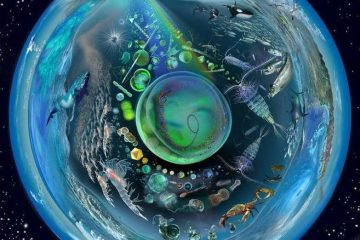Table of Contents
- Understanding the Gaia Hypothesis in the Context of Earth’s Biosphere
- Exploring Key Evidence Supporting the Gaia Hypothesis
- The Interconnectedness of Life and Earths Systems
- Implications for Sustainability and Environmental Stewardship
- Recommendations for Further Research on Gaia Principles
- Q&A
- In Summary
Understanding the Gaia Hypothesis in the Context of Earth’s Biosphere
The Gaia Hypothesis posits that the Earth functions as a self-regulating, complex system where living organisms interact with their inorganic surroundings to maintain conditions suitable for life. This idea is rooted in the interconnectedness of various components of the biosphere, including the atmosphere, hydrosphere, and lithosphere. The concept challenges the traditional view of nature as a collection of independent parts, asserting instead that the Earth is a unified whole. By examining evidence across various disciplines, we can appreciate how these interactions contribute to the planet’s stability and resilience.
Numerous examples highlight the Gaia Hypothesis in action. Key forms of evidence supporting this idea include:
- Climate Regulation: Oceanic and atmospheric processes work together to regulate temperatures and maintain the climate.
- Nutrient Cycling: The interdependence of different species ensures efficient recycling of nutrients, preventing depletion.
- Species Interconnectivity: Species often rely on one another for survival, showcasing a web of relationships essential for ecosystem health.
Additionally, the relationship between biodiversity and ecosystem stability can be understood through the lens of the Gaia Hypothesis. Table 1 below summarizes how different levels of biodiversity influence ecosystem function.
| Biodiversity Level | Ecosystem Function |
|---|---|
| High | Improved resilience to disturbances and a greater range of ecosystem services. |
| Moderate | Balanced functionality, with some vulnerability to environmental changes. |
| Low | Increased risk of collapse and poor adaptation to changes. |
By embracing the Gaia Hypothesis, we can deepen our understanding of Earth’s biosphere and the profound interconnections that sustain life. This perspective encourages a collective responsibility to protect and nurture the environment, recognizing that human well-being is intrinsically linked to planetary health.

Exploring Key Evidence Supporting the Gaia Hypothesis
The Gaia Hypothesis posits that our planet, through its biological and physical networks, behaves like a self-regulating system. This theory is greatly supported by various key pieces of evidence that illustrate the intricate relationships among organisms and their environment, which collectively contribute to the maintenance of conditions conducive to life. Some compelling aspects of this hypothesis include:
- Climate Regulation: The ability of Earth’s natural systems to control the climate can be seen in phenomena such as the role of forests in carbon absorption. Tropical rainforests, for instance, significantly impact local and global weather patterns.
- Atmospheric Composition: The balance of gases in the atmosphere, including oxygen, nitrogen, and carbon dioxide, is maintained by biological processes. Microorganisms in ocean and soil ecosystems, through cycles of photosynthesis and respiration, help regulate these gases over geological time periods.
- Biodiversity and Ecosystem Stability: Diverse ecosystems tend to be more resilient to changes and disturbances, illustrating interdependence—where a diverse range of species supports the health of the entire environment. The loss of a single species can destabilize this balance, demonstrating the system’s sensitivity.
Moreover, the geochemical cycles exemplify the Gaia Hypothesis. For example, the nitrogen cycle is a clear illustration of life’s impact on the planet. Here’s how various elements contribute:
| Element | Process | Impact on Ecosystem |
|---|---|---|
| Nitrogen | Fixation by bacteria | Supports plant growth and nutrient availability |
| Carbon | Photosynthesis by plants | Reduces greenhouse gases and regulates temperature |
| Oxygen | Respiration by animals | Vital for aerobic life forms |
This dynamic exchange demonstrates how life forms not only adapt to their environments but also actively shape Earth’s physical and chemical state. The interconnectedness observed within biomes and ecological systems reflects a deeper, harmonious relationship that underscores the concept of Earth as a self-sustaining entity. Understanding these processes provides a clearer vision of how life influences the planet and strengthens the arguments in favor of the Gaia Hypothesis.

The Interconnectedness of Life and Earths Systems
The delicate balance of life on Earth is a remarkable tapestry woven through countless interactions among living organisms and their physical environment. Every species, from the tiniest microorganisms to towering trees, plays a crucial role in maintaining the stability of the biosphere. This intricate web of relationships underscores the idea that life is deeply embedded in Earth’s systems, influencing and regulating the climate, soil health, and water cycles. Recognizing this interplay helps us understand how disruptions to one element can reverberate throughout the entire system.
Among the most compelling demonstrations of this concept is the role of vegetation in regulating atmospheric conditions. Plants not only produce oxygen and sequester carbon dioxide but also influence local weather patterns through transpiration. Here are some key contributions of forests and plants:
- Carbon sequestration: Trees absorb carbon dioxide, a major greenhouse gas, thereby helping to mitigate climate change.
- Soil conservation: The roots of plants prevent soil erosion, maintaining the vital topsoil required for agriculture and biodiversity.
- Water retention: Forests improve water cycles by enhancing precipitation and reducing runoff, which contributes to groundwater recharge.
Additionally, the concept of nested systems illustrates how ecosystems are interdependent. For instance, coral reefs provide critical habitats for a myriad of marine species while simultaneously acting as natural barriers that protect coastlines from erosion and storm surges. The following table highlights some of the connections between various ecosystems and their roles in supporting life:
| Ecosystem | Function | Impact on Other Systems |
|---|---|---|
| Forests | Carbon storage, habitat | Regulates climate, influences hydrology |
| Wetlands | Water filtration, flood control | Supports biodiversity, mitigates flooding |
| Coral Reefs | Coastal protection, biodiversity hotspot | Promotes healthy fisheries, protects shorelines |

Implications for Sustainability and Environmental Stewardship
The Gaia Hypothesis presents a compelling framework for understanding our planet as a self-regulating, complex system. This perspective has profound , as it encourages us to recognize the interconnectedness of all living organisms and their environment. By seeing Earth as a living entity, we are prompted to consider the impact of our actions not merely in isolation, but as part of a larger ecological tapestry. This recognition fosters a sense of responsibility toward the health and well-being of our planet.
One significant outcome of adopting the Gaia Hypothesis is the shift toward a more holistic approach in addressing environmental challenges. This means prioritizing solutions that align with the natural processes and rhythms of ecosystems. Methods such as regenerative agriculture and permaculture emphasize working with nature rather than against it. These practices can lead to the following benefits:
- Enhanced biodiversity – Promoting diverse biological communities helps maintain ecosystem functionality.
- Soil health improvement – Working with natural soil processes can restore lands degraded by conventional farming methods.
- Carbon sequestration – Practices that enhance plant growth contribute to mitigating climate change by capturing carbon dioxide.
In addition, the Gaia Hypothesis can influence policy-making at various levels. It advocates for policies that support ecological balance over short-term economic gain. Such initiatives could include:
| Policy Area | Potential Strategies |
|---|---|
| Renewable Energy | Subsidies for solar and wind projects |
| Sustainable Land Use | Incentives for conservation easements |
| Waste Management | Support for circular economy initiatives |
Ultimately, embracing the principles of the Gaia Hypothesis fosters a deeper respect for nature, which is essential for crafting a sustainable future. Understanding the delicate balance of our ecosystems can lead to innovative solutions that not only protect the environment but also enhance quality of life for all species on the planet. By instilling a sense of stewardship over our shared home, we can work collectively towards a thriving, resilient Earth.

Recommendations for Further Research on Gaia Principles
To deepen our understanding of Gaia principles and their implications for ecological science, future research should prioritize interdisciplinary approaches that integrate insights from biology, climatology, and sociology. By bridging these disciplines, researchers can explore how various ecosystems interact dynamically and contribute to global homeostasis. This collaborative methodology may yield insights into how organisms influence their environments and how environmental changes can feedback on living systems.
Furthermore, empirical studies should be designed to investigate the specific mechanisms by which the Gaia principles manifest in diverse ecosystems. Researchers could conduct long-term observations and experiments focused on areas such as:
- Microbial community interactions and their roles in nutrient cycling
- The impact of plant biodiversity on ecosystem resilience
- The effects of climate change on symbiotic relationships
A comparative analysis of different biomes could also provide crucial context. By using a table to organize findings and highlight key differences and similarities, researchers can paint a clearer picture of how Gaia principles operate across varying environmental conditions.
| Biome | Key Characteristics | Gaia Principles |
|---|---|---|
| Tropical Rainforest | High biodiversity, warm temperatures, high rainfall | Enhanced nutrient cycling, mutualistic relationships |
| Tundra | Cold temperatures, low biodiversity, permafrost | Stability through resilience in harsh conditions |
| Coral Reef | Highly diverse, sensitive to temperature and pH | Ecosystem balance through symbiosis and energy flow |
Lastly, it is essential for researchers to explore the anthropogenic impacts on these principles as human activities increasingly influence natural systems. Investigating how urbanization, agriculture, and pollution disrupt the balance of ecosystems will help illuminate pathways for sustainable practices. Emphasizing restorative measures and understanding our role in the larger ecological network could pave the way for innovative solutions that align with Gaia’s vision. By fostering collaboration among scientists, policymakers, and the public, we can promote a more integrated appreciation for the complexity of life on Earth.
Q&A
Q&A: Understanding the Gaia Hypothesis and Its Evidence
Q1: What is the Gaia Hypothesis? A: The Gaia Hypothesis, proposed by scientist James Lovelock in the 1970s, posits that Earth functions as a self-regulating system where living organisms interact with their inorganic surroundings to maintain conditions suitable for life. In simple terms, it suggests that life on Earth and the environment are interconnected and work together to sustain the planet.Q2: What evidence supports the Gaia Hypothesis? A: Several lines of evidence support the Gaia Hypothesis:
- Biogeochemical Cycles: The cycling of elements like carbon and nitrogen shows how biological processes regulate and maintain these essential nutrients in the environment.
- Atmospheric Composition: Observations indicate that the Earth’s atmosphere is regulated by life forms. For example, the balance of gases such as oxygen and carbon dioxide is largely influenced by photosynthetic and respiratory activities of plants and animals.
- Climate Stability: The Earth has maintained a relatively stable climate over geological time scales. Some scientists suggest this stability is due to feedback mechanisms that involve living organisms regulating the climate.
- Biodiversity: High levels of biodiversity contribute to ecosystem resilience, enabling it to recover from disturbances. This interdependence showcases how life contributes to the stability of environmental conditions.
Q3: Are there any criticisms of the Gaia Hypothesis? A: Yes, there are several criticisms. Some scientists argue that the Gaia Hypothesis lacks sufficient empirical evidence and suggest that Earth’s systems are too complex for the hypothesis to be universally applicable. Critics also raise concerns about the interpretation of biological feedback as intentional regulation, arguing that these processes can be better explained through standard ecological theories.
Q4: How does the Gaia Hypothesis relate to current environmental issues? A: The Gaia Hypothesis is particularly relevant today as we face environmental challenges such as climate change and biodiversity loss. It emphasizes the interconnectedness of life and the environment, which can encourage holistic approaches to conservation and sustainable development, acknowledging that altering one part of the system can have far-reaching impacts.
Q5: What are some practical implications of the Gaia Hypothesis for society? A: Recognizing the Earth as a living system can influence policies and practices in various fields, including agriculture, urban planning, and environmental conservation. It encourages sustainable practices that consider the health of entire ecosystems rather than individual components, potentially leading to more sustainable living practices and technologies.
Q6: How has the scientific community embraced or diverged from the Gaia Hypothesis? A: The scientific community is divided on the Gaia Hypothesis. While some view it as a valuable framework for understanding Earth’s systems, others prefer to study ecological relationships through more traditional scientific methods. Despite these differences, the Gaia Hypothesis has inspired a range of interdisciplinary research, highlighting the critical links between biology, geology, and environmental science.
Q7: Can the Gaia Hypothesis help us find solutions to climate change? A: While the Gaia Hypothesis itself may not offer specific solutions, it can inspire systems thinking that could lead to innovative strategies for combating climate change. By recognizing how interconnected our planet’s systems are, we may be able to create more effective policies and actions that harness natural processes to restore balance and mitigate environmental impact.



0 Comments